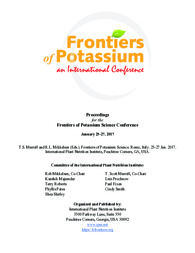Silt as K source for crops in tropical soils.
Silt as K source for crops in tropical soils.
Author(s): VOLF, M.; BENITES, V. de M.; ROSOLEM, A. C.; CRUSCIOL, A. C.; MORAES, F. M.; MENEZES, F. J.; SILVA, C. A.
Summary: The original soil exchangeable potassium (K) concentrations are at or above critical levels in many Brazilian Cerrado (savanna) soils. Hence, many cropped areas have been fertilized with low K rates, below crop requirements, but yields have not decreased as expected. In these areas, topsoil exchangeable K analyses have shown no decrease, or even some increase. The aim of this study was to evaluate exchangeable and non-exchangeable K forms in soils under different uses and managements in the Vale do Araguaia region of Mato Grosso state, Brazil. Soil samples were taken from 91 sites at depths of 0-20 cm and 20-40 cm, in areas under grain crops, pasture and native vegetation (Cerrado or forest). Silt content ranged from 12 to 175 g kg-1 and clay from 90 to 595 g kg-1, and the predominant clays were kaolinite, hematite, goethite and gibbsite. Under pasture, the soils had high levels of exchangeable K in the 0-20 cm layer and high levels of non-exchangeable K from 20 to 40 cm. This can be a result of the absorption of non-exchangeable K by grasses, the main cultivated species, by recycling K to the exchangeable fraction in the topsoil. There was a positive relationship between silt and non-exchangeable K contents. Ratios of exchangeable to non-exchangeable K were over 3 in soils with silt above 70 g kg-1, in which non-exchangeable K was over 100 mg dm-3. Cover crops growing in soils rich in silt take up non-exchangeable K and exchangeable K from deeper layers, which is recycled to the soil as exchangeable K upon plant residue mineralization, which may have been responsible for the maintenance or increase in exchangeable K levels in the 0-20 cm layer in areas where low K rates have been used for grain production.
Publication year: 2017
Types of publication: Paper in annals and proceedings
Unit: Embrapa Soils
Keywords: Cerrado, Solo, Vale do Araguaia
Observation
Some of Embrapa's publications are published as ePub files. To read them, use or download one of the following free software options to your computer or mobile device. Android: Google Play Books; IOS: iBooks; Windows and Linux: Calibre.
Access other publications
Access the Agricultural Research Database (BDPA) to consult Embrapa's full library collection and records.
Visit Embrapa Bookstore to purchase books and other publications sold by Embrapa.

